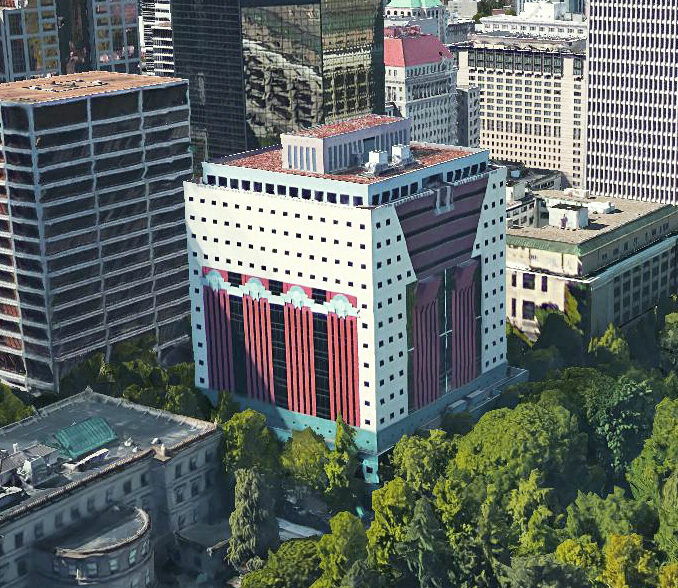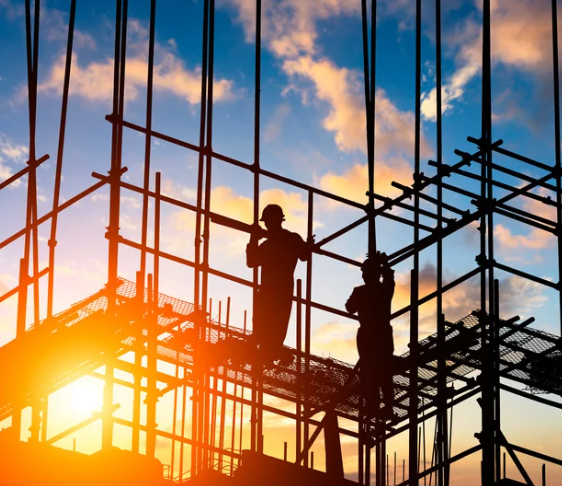AI Meets Lower Carbon Concrete
AI Meets Lower Carbon Concrete: Can Artificial Intelligence Help Build a Greener Future?
- Materials
Practices Engaged

AI Meets Lower Carbon Concrete: Can Artificial Intelligence Help Build a Greener Future?Concrete, a composite building material made from a mixture of various aggregates, cement, and water, accounts for a staggering 8% of global greenhouse gas emissions. If concrete were a country, it would rank third in emissions behind the US and China. With such a massive environmental footprint, reducing concrete’s carbon impact is crucial for addressing climate change. In the pursuit of greener building practices, lower carbon concrete has emerged as a key solution. By utilizing alternative materials and strategies that refine the overall process of mixing, curing, and placing concrete, the industry has the opportunity to significantly reduce the associated carbon emissions. And as we seek innovative ways to accelerate this shift, emerging technologies like Artificial Intelligence (AI) are being explored. Yet, while AI holds great potential in many fields, its application in concrete mix design faces significant challenges. As Chris Forney, Partner at Brightworks Sustainability, points out, “AI is an excellent tool for modeling, and with the right types of inputs, you can rapidly develop alternatives. But when we’re talking about new mix designs and novel approaches to low carbon concrete, that’s where it’s really hard to substitute the human factor, at least at this point in the evolution of concrete mix design.” A lack of reliable data, along with the complexity of concrete’s chemistry and its dependence on site-specific conditions, has experts concerned about AI’s current ability to guide sustainable solutions effectively. As we explore the strategies for reducing concrete’s carbon impact, we also need to critically assess AI’s role in this evolving landscape. Concrete 101: Understanding the BasicsConcrete is everywhere. It’s under your feet, surrounding your workspace, and shaping the cities we live in. The foundation of concrete is a mixture of cement, water, and aggregates like sand and gravel. When combined, these ingredients undergo a chemical reaction called hydration, hardening into one of the most durable and versatile materials on the planet. The proportion and selection of ingredients for concrete are carefully designed in what’s known as concrete mix design. This process determines the exact ratio of cement, water, aggregates, and sometimes additives, to achieve the desired strength, durability, and performance of the concrete for a specific project. A good mix design supports the concrete’s ability to perform well under the environmental conditions and stresses it will face throughout its lifespan. In essence, mix design is both a science and an art, requiring a deep understanding of materials and their behaviors when mixed together. Despite its strength and ubiquity, concrete comes with a significant environmental cost. The largest contributor to concrete’s greenhouse gas emissions is cement, its key binding ingredient. Cement is just one component of concrete (the terms are not interchangeable, as often mistaken), and it is incredibly energy-intensive, primarily due to the high emissions generated during its production. The majority of emissions come from the kiln-firing process, where limestone and other minerals are heated at extremely high temperatures, often powered by coal or natural gas. This process, along with the chemical reactions involved in creating cement, is the primary reason why concrete’s carbon footprint is so high. This presents a critical challenge: how do we maintain concrete’s benefits while drastically reducing its environmental impact? That’s where lower carbon concrete comes in. AI in Concrete: A Cautionary TaleUsing AI to optimize lower carbon concrete mix design involves feeding it large volumes of data–hundreds or thousands of mix formulas–so it can identify patterns and recommend the best combinations. This method assumes that the necessary data to produce reliable results is both available and accurate. However, as Forney explains, this assumption is problematic. “Drawing a line backward and using the trajectory to draw a line forward is going to lead to conclusions that are based on a historical experience that we’re trying to bend.” The data AI relies on may not fully represent the complexities of new mix designs and innovative, lower carbon materials and strategies. AI could be fed an abundance of specification information, structural requirements, testing results, and mix design details. Theoretically, it could analyze this information and start generating optimized mixes. However, AI breaks down when considering the numerous issues and nuances that occur outside of documentation, especially in the field. As Chris Bennett, a founder and partner at Tao Group Solutions, explains, concrete’s behavior is influenced by factors including human intervention, temperature, humidity, materials, and site-specific conditions, that AI cannot easily model. “It’s not just what’s in the cookie batter,” Bennett says. “AI is not R&D,” adds Jeff Frost, Materials Technical Lead at Brightworks Sustainability. “You don’t have it out in the field playing around to figure out how things are going to work together. It takes chemists, material scientists, people who appreciate and value each material uniquely that can help figure it all out,” he continues. For mix designs, it is far too common for batch plants to adjust mix ingredients and not always report these changes. It is also common for extra water to be added at the mix plants, in the truck on the drive to the project, in the field while trucks are waiting, or even during placement or finishing. Again, this is not always reported. Furthermore, material qualities are not always what you see on paper. “Aggregates are not all the same from region to region,” Frost notes. “Quality of Portland Limestone Cement can vary between shipments and regions, which impacts performance. SCMs are the same with variations impacting the ‘chemistry and behavior’ of the mix, usually requiring field adjustments, which are, again, not always documented.” “Application of petroleum-based densifiers and grout coats, usually to ‘fix’ issues with the concrete mix/placement, are often not captured as data to inform AI modeling,” Frost continues. “Nor are benchmarks being captured to show how a slab actually performed in the field: Did it crack? Craze? Spall?” Weather is also a factor that can impact not only the efficiency of the hydration process but can significantly impact curing and workability. Additionally, testing, such as cylinders, is often cured in the lab under very different conditions from the field which can lead to mis-aligned test results. Outdated testing practices often make it challenging to measure true strength when using newer concrete innovations. “When you consider all of these factors, often not documented, often outdated, it is hard to say that the underlying data we’d be feeding into AI’s LLM [large language model] would truly be representative of high performance, durable concrete,” Frost says. Fortunately, groundwork is underway to develop effective strategies for lower carbon concrete. Teams of professionals, including Brightworks Sustainability and Tao Group Solutions, are working to gather the necessary data and focus not only on global warming potential but also on the other performance metrics essential for optimizing lower carbon solutions. Cementing the Future of ConcreteThere are two key strategies for achieving lower carbon concrete, explains Bennett, a technical expert on the subject. These strategies are critical to reducing concrete’s environmental impact and, when properly executed, help guide sustainable concrete design in a way that AI currently cannot. “The first strategy is cement reduction–rebating cement with something that has a lower global warming potential,” Bennett says. One of the main ways to reduce the amount of cement in concrete by replacing it with alternative materials, or SCM’s (substitute cementitious materials). Examples of SCMs include fly ash (a fine powder byproduct from coal combustion in power plants) or slag (a byproduct of molten iron production in blast furnaces). These substitutions alter the mix design and chemistry of concrete, leading to reduced greenhouse gas emissions. Bennett notes that this strategy has been the more traditional and widely-marketed approach for lower carbon concrete globally. However, Bennett notes that cement reduction alone isn’t enough to fully tackle carbon emissions. “The second strategy focuses on increasing the efficiency of hydrolysis, or curing. This is the reaction between your cement, binding agents, and water,” Bennett explains. By making this curing process more efficient, less cement is required overall, leading to a lower carbon footprint. “You can have a lower carbon concrete mix and still create high-durability concrete. But when both strategies are aligned–reduced cement use and more efficient curing–you can create concrete that is very durable and very sustainable,” he continues. Forney adds, “The second strategy is our differentiator, and one we’re excited to bring to teams. It’s an integrative process.” Fluency is ParamountThe strategies for creating lower carbon concrete go hand in hand with engaging everyone involved in the process, from the owners, contractors, and engineers to crews executing the work on-site. For Brightworks Sustainability and Tao Group Solutions, this education begins at the very start of the project. “Team engagement starts with understanding the owner’s expectations and helping them articulate these goals in more technical terms, specifically regarding concrete design expectations, opportunities, and challenges,” Forney explains. “Then, we work with engineers and architects to explore the range of possibilities for meeting these expectations transparently and thoroughly. Finally, we crosswalk this with the construction team to validate smart design strategies with smart implementation strategies.” What ultimately results from the design team is a set of expectations that are more rigorously tested and proven than what has historically been asked in the past with concrete design, particularly in terms of meeting performance, cost, and preferences for different technologies and products with verifiable results and clearer understanding and fluency to adapt along the way. “Any one of these team members can put the brakes on a lower carbon mix design very quickly. Maybe they’re not familiar or comfortable with it, or they don’t want to take the risk. Our job is to guide the entire team across the ‘valley of death’ to arrive at a high-performance, lower carbon solution on the other side,” Forney says. Bennett sums up the importance of an integrated team, saying, “Without understanding the desired outcome and the best technical approach to achieve it, and without the time and resources to invest in the process, you can’t make lower carbon concrete what it should be: the least-expensive and most-effective path to concrete construction.” Navigating the “Valley of Death”However, bringing these new ideas into the field can be challenging. “Historically, contractors have had little experience with sequestering, PLC, and high SCM mixes,” Bennett says. “The behavior changes as a material are significant. The amount of water needed is different. The mechanical execution is different. So, you have a very talented, very skilled workforce expecting lower carbon concrete to behave in the same way as traditional concrete, but when it doesn’t, they’re unsure how to proceed and default to traditional approaches that make the situation worse.” Bennett points out that contractors are under immense pressure to meet deadlines and deliver results, leaving little time for experimentation and education. “People have not been prepared for this difference. When substantial changes are made to mix designs, it can be difficult to translate those changes to the field and truly understand what’s being asked of the workers,” he adds. For Brightworks Sustainability, this challenge has led to the creation of new services to bridge the gap. “Through collaboration with experts like Tao Group Solutions, we’ve been able to achieve impactful results,” Forney says. “From the start of the project, we help the owner better define their concrete design expectations and help articulate them more technically. We then work with engineers and architects to explore how to meet those expectations and ensure that the construction team is on the same page.” Lower Carbon Concrete in ActionBrightworks Sustainability and Tao Group Solutions work with a wide range of clients to develop lower carbon concrete solutions and tackle various related challenges. One such client had previously struggled with more traditional, widely-marketed approaches to lower carbon concrete, relying heavily on cement replacements like fly ash and slag. However, their methods led to poor results: concrete floor failures within just a year or two, delayed store openings, and the depletion of contingency budgets. Despite following these methods for years, the outcomes were far from the intended goal of creating a durable, functional structure. Bennett and his team took a hands-on approach by conducting detailed mock-ups, testing both existing and new concrete mixes. “We were able to show not only significant reductions in global warming potential but also water conservation benefits, which are often overlooked,” Bennett explains. He emphasizes that simply changing ingredients in the mix is not enough. Altering the entire process of concrete creation is key to achieving true lower carbon outcomes. “Lower carbon concrete often requires more water if you’re only changing ingredients, but adjusting the production process itself makes all the difference.” Being on-site proved essential in refining the solution. “We didn’t just focus on the theoretical. We observed what was needed in the field and worked to shape the specifications to reflect those realities,” Bennett says. The final analysis considered not only the global warming potential and durability of the concrete but also the aesthetic elements that were important to the client. The outcome was a more holistic approach that met the client’s practical and environmental needs, highlighting the value of being on-site rather than making broad, theoretical changes from a distance. The Path ForwardThe push towards lower carbon concrete requires more than just technological innovation; it demands real-world application and expertise. While AI will likely one day play an important role in optimizing mix design, AI machine learning’s current limitations highlight the necessity of human collaboration. With collaboration at its core, the pursuit of lower carbon concrete has the power to transform the built environment, with more sustainable foundations, buildings, and infrastructure for generations to come. Written by Corey Hastings, Marketing Consultant |


Starwood Hotels & Resorts
1 Hotel Hanalei Bay Luxury Resort
Starwood Hotels & Resorts
1 Hotel Hanalei Bay Luxury Resort
Princeville, HI
Brightworks provided LEED certification management and energy services to support Starwood Hotels with the major renovation and rebranding of Kauai’s Princeville Hotel into a flagship 1 Hotel resort focused on sustainable hospitality and wellness. Brightworks collaborated with the design and construction team to incorporate innovative strategies that will save energy and water, improve operations, and protect local ecosystems. Brightworks also delivered comprehensive energy modeling services, which allowed the project team to identify energy conservation measures and evaluate options.
Practices Engaged:
Sustainable Built Environments
Industry Sectors:
Hotel
Building Types:
Hotels & Resorts


Gerding Edlen
5 MLK Apartments
Gerding Edlen
5 MLK Apartments
Portland, OR
This biophilically-designed tower achieved LEED Gold and Fitwel 1 Star certification while also featuring a resiliency program. The building offers 100,000 square feet of offices on lower floors and 220 residential units with landscaped terraces above.
Practices Engaged:
Sustainable Built Environments, Healthier Built Environments
Industry Sectors:
Residential
Building Types:
Luxury Residential


City of Portland
Case Study
City of Portland
Case Study
Practices Engaged:
Healthier Built Environments
Industry Sectors:
Corporate, Government, State & Local
Building Types:
Historic Buildings
Read more


ABB
North American GreenCRREM Assessments
ABB
North American GreenCRREM Assessments
Arkansas, California, Florida, Georgia, Michican, Missouri, Mississippi, North Carolina, New Jersey, New Mexico, Oklahoma, Pennsylvania, South Carolina, Tennessee, Texas, Virginia, Wisconsin, West Virginia
ABB is a global leader in industrial technology. Across 17 states, Brightworks conducted sustainability assessments on more than 50 buildings in ABB's North American portfolio, including manufacturing, office, and warehousing facilities. An extensive report providing a baseline assessment for each site helped ABB prioritize energy efficiency measures, budget for carbon reduction efforts, and calculate ROI as part of its GreenCRREM program.
Practices Engaged:
Sustainable Built Environments, Carbon, Energy
Industry Sectors:
Corporate, Manufacturing


Salesforce
Case Study
Salesforce
Case Study
This letter to the industry highlights the urgent need to address embodied carbon in MEP/IT/AV systems. While operational emissions have seen progress, this embodied carbon remains a challenge. This article reveals insights to guide the industry toward a 50% reduction by 2030 to stay on track for meeting net-zero carbon targets for 2050.
Practices Engaged:
ESG + Corporate Sustainability, Sustainable Built Environments, Carbon, Materials
Read more


AI Meets Lower Carbon Concrete
AI Meets Lower Carbon Concrete
Concrete accounts for 8% of global GHG emissions, which is more than every country except the US and China. Lower carbon concrete is a critical climate solution, but designing it isn’t simple. While AI offers promise, experts warn of its limitations in capturing real-world variables. This post explores why human expertise still leads the way, and how integrative strategies are reshaping concrete’s future.
Practices Engaged:
Materials
Read more

-
U.S. GSA Diplomatic Security OfficeDiplomatic Security Office | Seattle, WA
-
U.S. Social Security Administration OfficeVan Nuys Office | CA